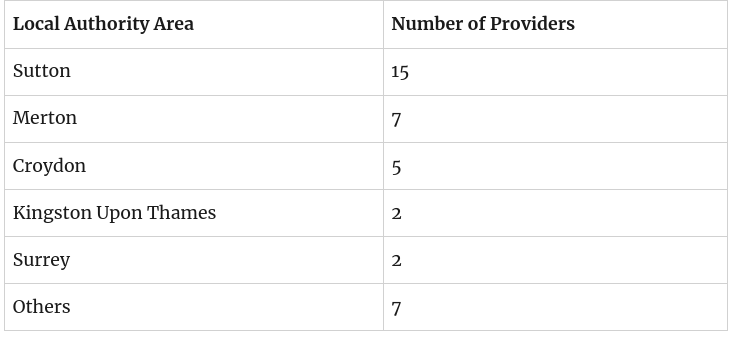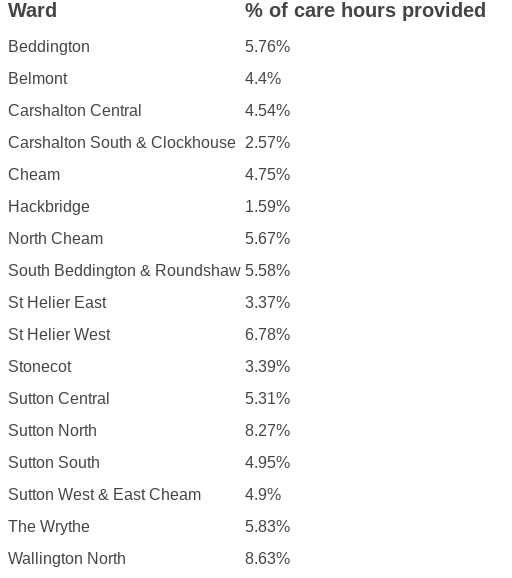Community Services – Home Care
Last Updated: 01 June 2023
Where are we now
The provision of local high quality home care is a key priority for Sutton. These services provide care and support to individuals who need it the most, supporting them to remain independent for as long as possible, usually in their own homes.
The purpose of home care services is to deliver personalised care and support that maintains and improves wellbeing, independence and resilience appropriate to each individual’s needs and circumstances. This should include their state of health and personal aspirations to live as full and as inclusive a life as possible.
Within Sutton there are 38 home care providers providing care and support to adults aged 18+ . Providers of home care provision are registered with the Care Quality Commission (CQC), as they provide personal care to the individuals living in Sutton.
Demand for home care increased significantly during 2021/22 compared to the previous year. In 2020/21, packages of care were delivered to an average of 789 service users per month, compared to 955 in 2021/22. Sutton is working to improve the quality and supply of home care across the Borough to meet this rising demand by working with the home care market.
Over the last year Sutton has introduced a number of measures to support the market to enable the recruitment of well trained staff to meet these demands.
Diagram 1 : CQC Ratings of Home Care Providers
Data Source: CQC (December 2022)
Overall quality in the home care market is good. The graph above shows that of the 38 home care providers, 73.68% (28) are rated as ‘good’ by CQC, with 1 provider (2.63%) rated as ‘outstanding’. Six providers (15.79%) are rated as ‘requiring improvement’, with 2 providers (5.26%) awaiting inspection by CQC. There is 1 provider (2.63%) who is CQC exempt.
Our current large provider base requires significant contract management and quality assurance activity, to monitor performance and maintain acceptable standards of care.
Table 1 : Local Authority Area of Provider Registration

Source: CQC (December 2022)
The table above shows the Local Authority area in which the 38 providers are registered. Of these 38 providers, 15 providers (39.5%) are registered in Sutton, 7 (18.42%) are registered in Merton, 5 (13.16%) in Croydon, 2 (5.26%) in Kingston Upon Thames, 2 (5.26%) Surrey, and the remaining 7 providers (18.2%) are registered elsewhere.
Table 2 : Percentage of Care Hours Delivered by Ward

Source: Adult Social Care Sutton (December 2022)
The table above shows the percentage of care hours being delivered in each ward within Sutton, during a period of 1 week in December 2022. The ward of Wallington North represents the largest proportion of home care delivery at 8.63% (1,400 hours), followed by Sutton North (1,341.88 hours). The wards with the lowest proportion of care hours delivered were Carshalton South and Clockhouse at 2.57% (416.75 hours) and Hackbridge at 1.59% (257.5 hours). The average number of hours of care being delivered in each ward was 809.59. Care being provided outside of the Borough amounted to 33.75 hours (0.21%).
Diagram 2 : Number of Hours of Care Delivered Per Week (By Age)
Source: Adult Social Care Sutton (December 2022)
The graph above indicates that the adult age group (age 18+) receiving the lowest number of care hours are those aged 18 to 25, who receive 237.75 hours of care per week (1.47%). Those aged 26 to 49, receive 846.75 hours of care (5.22%), with 50 to 64 year olds receiving 1495.88 hours (9.22%). The older adult age groups receive the highest number of care hours with those aged 65 to 74 receiving 2172.13 hours (13.39%), 75 to 84 year olds receiving 4934.29 hours (30.41%), those aged 85 to 94s receiving 5347.17 (32.96%), and the oldest age group of 95+ receiving 1191.56 (7.34%).
Diagram 3 : Hours of Care Provided (per week) by Primary Support Reason
Source: Adult Social Care Sutton (December 2022)
Individuals who are identified as having an eligible need for ongoing care and support have their support reasons identified and recorded. The graph above shows the breakdown of the hours of care being delivered per week by primary support reason. Of the hours of care being provided each week to individuals by primary support reason, just over three quarters of care hours (75.6%) are being provided to those for whom physical support is their primary support reason (12,264.48 hours). Memory & cognition is the primary support reason recorded for 11.2% (1823.17 hours) of the remaining care hours provided followed by learning disability at 5.3% (856.13 hours), mental health at 4.8% (775 hours), sensory support at 2.8% (455.25 hours), and social support at 0.3% (51.5 hours).
Diagram 4 : Weekly Cost of Care by Primary Support Reason
Source: Adult Social Care Sutton (December 2022)
The pie chart above shows the weekly cost of care for each primary support reason. Just over three quarters (75.8%) of spend on home care is for those adults with physical support recorded as their primary support reason. Memory & cognition represents the second largest spend area (11.3%), followed by mental health (4.9%), learning disability (4.8%), sensory support (2.8%), and social support (0.3%).
Our Home Care Market – Adults Aged 18 +
Within Sutton there are 38 Care Quality Commission (CQC) regulated home care providers delivering long term care and support to over 1065 adults aged 18+ living in their own homes.
Diagram 5 : Service Users by Age
Data Source: Adults Social Care Sutton (December 2022)
The graph above shows that adults aged 75+ account for the majority of those receiving home care in Sutton, with those aged 85 to 94 being the largest group. Of this majority group, 310 adults (29.11%) are aged 75 to 84, 340 adults (31.92%) are aged 85 to 94, and 70 adults (6.57%) are aged 95+. Of the adults under the age of 75, 24 adults (2.25%) are aged 18 to 25, 60 adults (5.63%) are aged 26 to 49, 111 adults (10.42%) are aged 50 to 64, and 150 adults(14.08%) are aged 65 to 74.
Diagram 6 : Service Users by Gender
Data Source: Adults Social Care Sutton (December 2022)
The graph above shows that of the 1065 service users receiving home care, 666 (62.5%) identify as female and 399 (37.5%) identify as male.
As part of the adult social care assessment process, individuals who are identified as having an eligible need for ongoing care and support, have their ‘Primary Support Reason’ identified and recorded. Individuals may have a number of identified needs, however a primary reason for support will always be identified.
Diagram 7 : Service Primary Support Reason for Adults in Receipt of Home Care
Data Source: Adults Social Care Sutton (December 2022)
The pie chart above shows the breakdown of primary support reasons for adults aged 18+ who are receiving home care. Those adults with a primary support reason of physical support make up almost three quarters (74.1%) of individuals receiving home care. The remaining quarter receive home care for memory and cognition (8.7%), mental health (8.1%), learning disability (5.4%), sensory support (3%), and social support (0.7%).
The graphs and narrative below provide further information on the amount of care hours delivered per week by age for each of the primary support reasons.
Diagram 8 : Number of Care Hours Being Delivered Per Week By Age (Physical Support)
Source: Adult Social Care Sutton (December 2022)
A total of 12,264.48 hours of home care per week are provided to those individuals for whom physical support is recorded as being their primary support reason. Of this total of hours per week, 4 hours of care per week are delivered to those aged 18 to 25 (0.03%), 365.25 hours to those aged 26 to 49 (2.98%), 1017.25 hours to those aged 50 to 64 (8.29%), 1639.63 hours to those aged 65 to 74 (13.37%), 3911.63 hours to those aged 75 to 84 (31.89%), 4259.17 hours to those aged 85 to 94 (34.73%), and 1067.56 hours to those individuals aged 95+ (8.7%).
Diagram 9 : Service User Gender (Physical Support)
Source: Adult Social Care Sutton (December 2022)
Of those service users receiving home care whose primary support reason is recorded as physical support, 64.9% identify as female and 35.1% identify as male.
Diagram 10 : Number of Care Hours Delivered Per Week By Age (Memory and Cognition)
Source: Adult Social Care Sutton (December 2022)
A total of 1823.17 hours of home care per week are provided to those individuals for whom memory & cognition is recorded as being their primary support reason. Of this total of hours per week, 12 hours of care per week are delivered to those aged 50 to 64 (0.7%), 166.5 hours to those aged 65 to 74 (9.1%), 781.17 hours to those aged 75 to 84 (42.8%), 810 hours to those aged 85 to 94 (44.4%) and 53.5 hours to those individuals aged 95+ (2.9%).
Diagram 11 : Service User Gender (Memory and Cognition)
Source: Adult Social Care Sutton (December 2022)
Of those service users receiving home care whose primary support reason is recorded as memory and cognition, almost three quarters (74.2%) identify as female and 25.8% identify as male.
Diagram 12 : Care Hours Provided Per Week By Age (Mental Health)
Source: Adult Social Care Sutton (December 2022)
A total of 775 hours of home care per week are provided to those individuals for whom mental health is recorded as being their primary support reason. Of this total of hours per week, 66.25 hours (8.5%) are delivered to those aged 18 to 25, 92.25 hours (11.9%) to those aged 26 to 49, 201.5 hours (26%) to those aged 50 to 64, 224.5 hours (29%) to those aged 65 to 74, 134 hours (17.3%) to those aged 75 to 84, 29.75 hours (3.8%) to those aged 85- to 94, and 26.75 hours (3.5%) to those individuals aged 95+.
Diagram 13 : Service User Gender (Mental Health)
Source: Adult Social Care Sutton (December 2022)
Of those service users whose primary support reason is recorded as mental health, just over half (51.2%) identify as male and 48.8% identify as female.
Diagram 14 : Care Hours Provided Per Week by Age (Learning Disability)
Source: Adult Social Care Sutton (December 2022)
A total of 856.13 hours of home care per week are provided to those individuals for whom learning disability is recorded as their primary support reason. Of this total of hours per week, 163.5 hours (19.1%) of care per week are delivered to those aged 18 to 25, 389.25 hours (45.5%) to those aged 26 to 49, 194.38 hours (22.7%) to those aged 50 to 64, 60.25 hours (7%) to those aged 65 to 74, 38.25 hours (4.5%) to those aged 75 to 84, and 10.5 hours (1.2%) to those individuals aged 85 to 94.
Diagram 15 : Service User Gender (Learning Disability)
Source: Adult Social Care Sutton (December 2022)
Of those service users whose primary support reason is recorded as learning disability, over two thirds (69%) identify as male and 31% identify as female.
Diagram 16 : Care Hours Provided Per Week By Age (Sensory Support)
Source: Adult Social Care Sutton (December 2022)
A total of 455.25 hours of home care per week are provided to those individuals for whom sensory support is recorded as their primary support reason. Of this total of hours per week, 59 hours (13%) of care per week are delivered to those aged 50 to 64, 46.5 hours (10.2%) to those aged 65 to 74, 68.25 hours (15%) to those aged 75 to 84, 237.75 hours (52.2%) to those aged 85 to 94, and 43.75 hours (9.6%) to those individuals aged 95+.
Diagram 17 : Service User Gender (Sensory Support)
Source: Adult Social Care Sutton (December 2022)
Of those service users whose primary support reason is recorded as sensory support, 68.8% identify as female and 31.3% identify as male.
Diagram 18 : Definition of adults with sensory support as their primary support reason
Source: Adult Social Care Sutton (December 2022)
Of the 32 service users identified as having sensory support as their primary support reason, 23 (71.9%) require support for a visual impairment, 8 (25%) require support for a hearing impairment, and 1 (3.1%) requires support for dual impairment.
Diagram 19 : Care Hours Provided Per Week By Age (Social Support)
Source: Adult Social Care Sutton (December 2022)
A total of 51.5 hours of home care per week are provided to individuals for whom social support is recorded as their primary support reason. Of this total of hours per week, 4 hours (7.77%) of care per week are provided to those aged 18 to 25, 11.75 hours (22.82%) are provided to those aged 50 to 64, 34.75 hours (67.48%) are provided to those aged 65 to 74, and one hour per week (1.94%) is provided to those aged 75 to 84.
Diagram 20 : Service User Gender (Social Support)
Source: Adult Social Care Sutton (December 2022)
Of those service users for whose primary support reason is recorded as social support, over half (57.1%) identify as male and 42.9% identify as female.
Diagram 21 : Definition of adults with social support as their primary support reason
Source: Adult Social Care Sutton (December 2022)
Of the 7 service users identified as having social support as their primary support reason, 4 (57.1%) require support for social isolation/other, and 3 (42.9%) require support for substance misuse.
Where we want to be – Our Vision
Over the next 6 years (2023-2029) our vision for home care provision includes a reformed model of ethical, strengths-based care and support, which meets the needs and aspirations of adults and enables them to live independently in their own home and community.
Our aims in commissioning a sustainable and high quality home care provision includes:
- More choice and control for service users
- More flexible and integrated services that offer value for money
- Quality services at an affordable cost that focus on commissioning outcomes with a strong emphasis on enabling people to live independently
- Services that promote independence, recovery, rehabilitation and reablement
- Services that prevent ill health and promote well being
- Support for people to regain or attain independence outside of social care services wherever this is possible
- Greater understanding and use of tech enabled assistive technology options to enable independent living
Challenges and Market Influencers
There are a number of challenges in the delivery of home care services in Sutton including;
- Recruitment and retention of staff
- Variable workforce development standard
- A wide range of fees that affects sustainability of home care services
- Inconsistent quality of services being delivered
- Increasing complexity of service user needs
- Need for dedicated specialist providers in the market to improve the services for people with a learning disability and mental health needs.
- Need for closer working relationships with local hospitals and health teams to support the prevention of hospital admission and timely discharge from hospital
Need and Demand
Demand for home care increased significantly during 2021/22 compared to the previous year. In 2020/21, packages of care were delivered to an average of 789 service users per month, compared to 955 in 2021/22.
How we need the market to develop for the future
Sutton has reviewed existing home care data and trends, engaged with partners and stakeholders in health and adult social care, residents and our current providers. In collaboration with our stakeholders and to improve the local home care market and tackle the challenges we have identified, the following actions and approaches are being developed and delivered:
- A new model for home care delivery that is focused on prevention and maintenance of well-being
- Lead home care providers operating in smaller geographical areas that will provide continuity of care for residents and improve service reliability by reducing travel time
- An outcomes focused home care service that will incentivise providers to flexibly manage care to achieve positive independence outcomes for individuals
- An enabling care approach that is broader than the traditional home service
- Revised business operations that provide extended business hours and staffing cover to enable a more person-centred service
- The introduction of a new Trusted Assessor role in the provider workforce to coordinate support, signpost and connect residents to local community facilities and prescribe minor pieces of equipment in a timely way to avoid delays
The benefits that have been outlined will contribute to building on individual and community resilience to enable people to maintain their independence and live safely in their homes.
